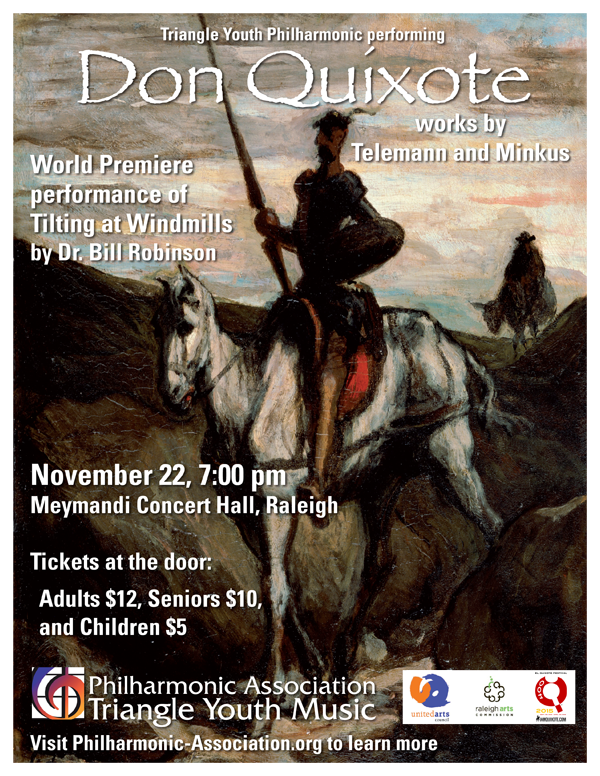El Quixote Festival Concert: NOVEMBER 22, 2015 – 7:00PM
In the Triangle Youth Philharmonic's concert in Meymandi Concert Hall on November 22, 2015 at 7:00 pm, the orchestra will present opera and ballet music inspired by Don Quixote. Works by: Telemann, Minkus &  The World Premiere performance of Tilting at Windmills by Dr. Bill Robinson.
The World Premiere performance of Tilting at Windmills by Dr. Bill Robinson.
Tickets at the door: Adults $12, Seniors, $10, Children $5
GET TICKETS HERE.
 Directions: Click Here
Directions: Click Here
Telemann Don Quixote Suite
Bill Robinson Tilting At Windmills
Tchaikovsky Symphony No.5
Hugh Partridge, Conductor
Rashad Hayward, Assistant Conductor
Margaret Partridge Executive Director of Triangle Youth Philharmonic and Composer DR. Bill Robinson interview on The Classic Station
click to hear!
Original Score – Tilting at windmills – Dr. Bill Robinson
Tilting at Windmills, by Bill Robinson
performed by the winds, brass, and percussion of the Triangle Youth Philharmonic, conducted by Rashad Hayward, as part of the El Quixote Festival concert at Meymandi Concert Hall, Raleigh, NC. In May 2015, Hugh Partridge, music director of the Triangle Youth Philharmonic here in Raleigh, North Carolina, asked me to write a piece with the theme of Don Quixote for performance in the fall. The maximum duration was to be ten minutes, and the instrumentation was for all of his musicians, minus the strings. (This was because they were playing a string orchestra piece, and he wanted everyone to have the chance to play.) As a result, the instrumentation is for piccolo, 3 flutes, 2 oboes, 4 bassoons, 4 clarinets, one bass clarinet, 2 alto saxophones, tenor and baritone saxophones, 4 horns, 4 trumpets, 2 trombones, bass trombone, tuba, timpani, glockenspiel, and castanets. To allow for more chances of performance, I have another edition scored for a more standard concert band. The programmatic aspects of this piece are rather general. The first movement is a relatively gentle and lyrical movement, reflecting the portrayal of Dulcinea (in the illusory version perceived by Don Quixote). The second movement, although clearly written by a composer whose heritage is far from the Iberian tradition, shows some Spanish influences, and is based on the Sevillana dance form. In general I do not compose for unpitched percussion, but I made an exception in this piece in order to include two percussionists in addition to the timpanist. It works pretty well, and I might allow myself more excursions into this in the future; but do not expect a trap set in any of my concerts. There is a version of Sevillana for woodwind quintet and piano.


